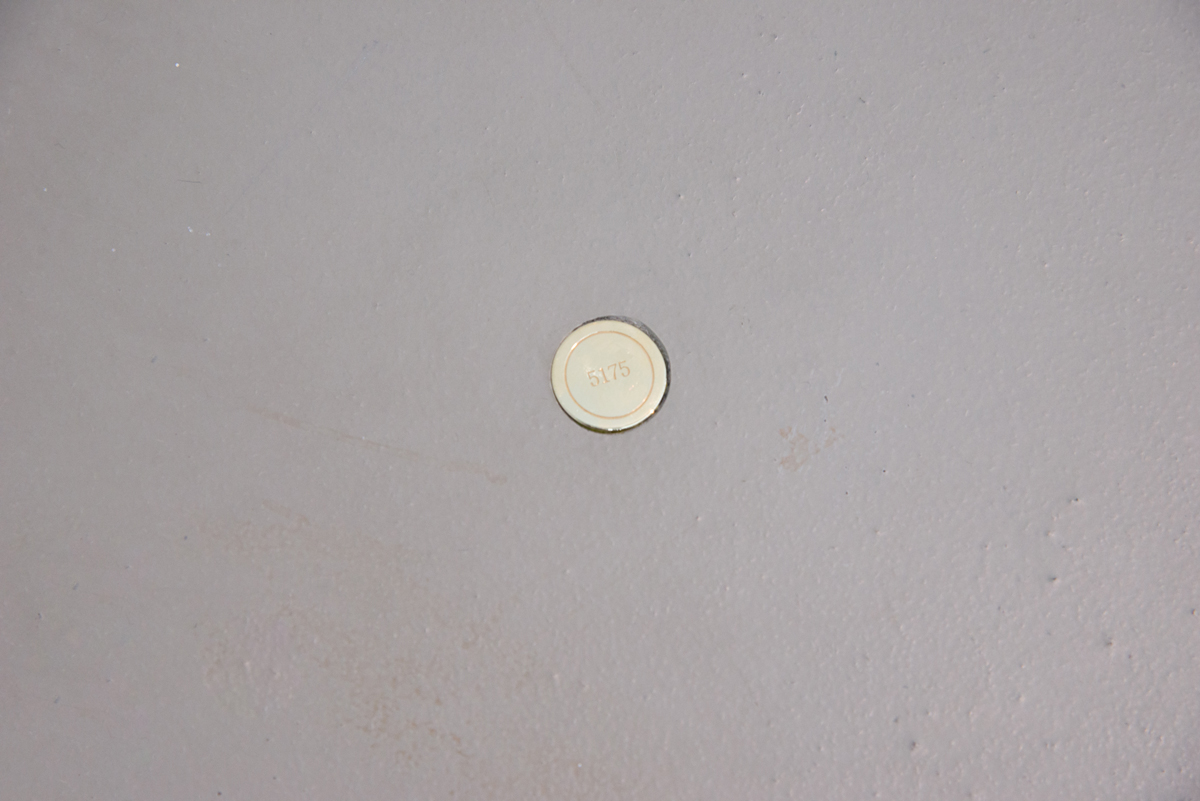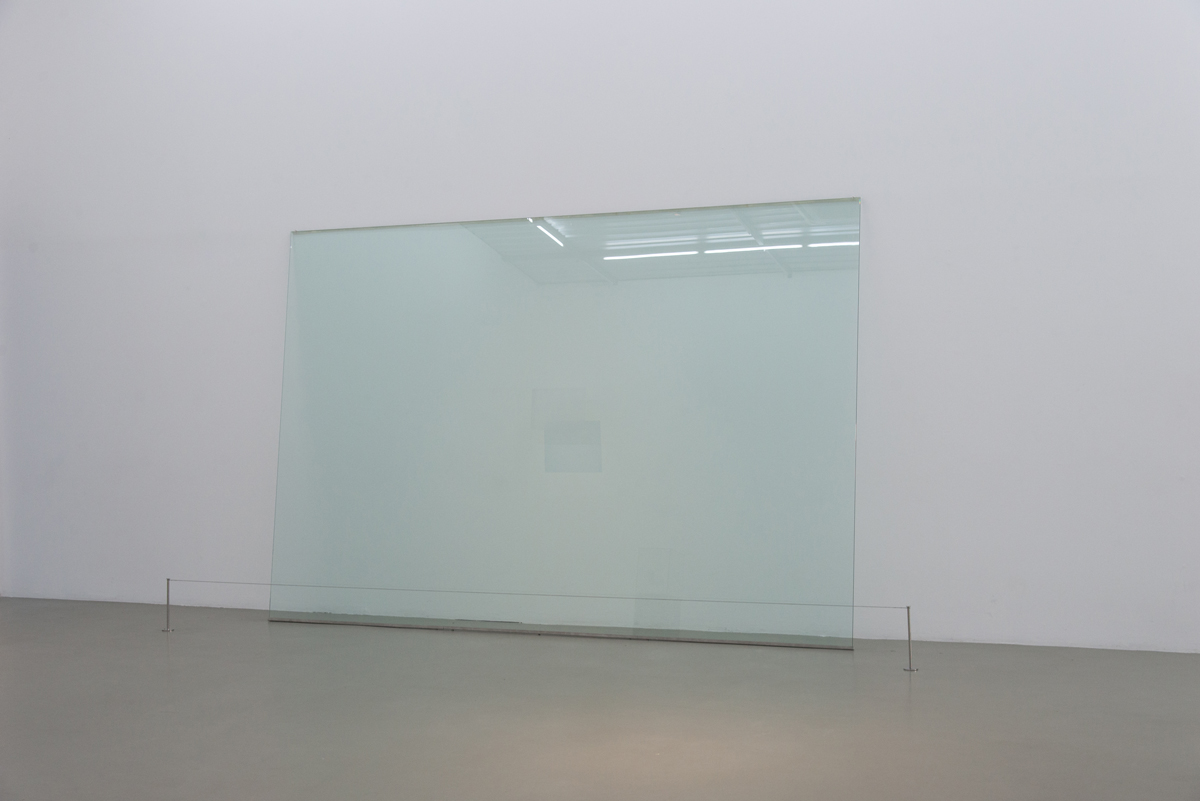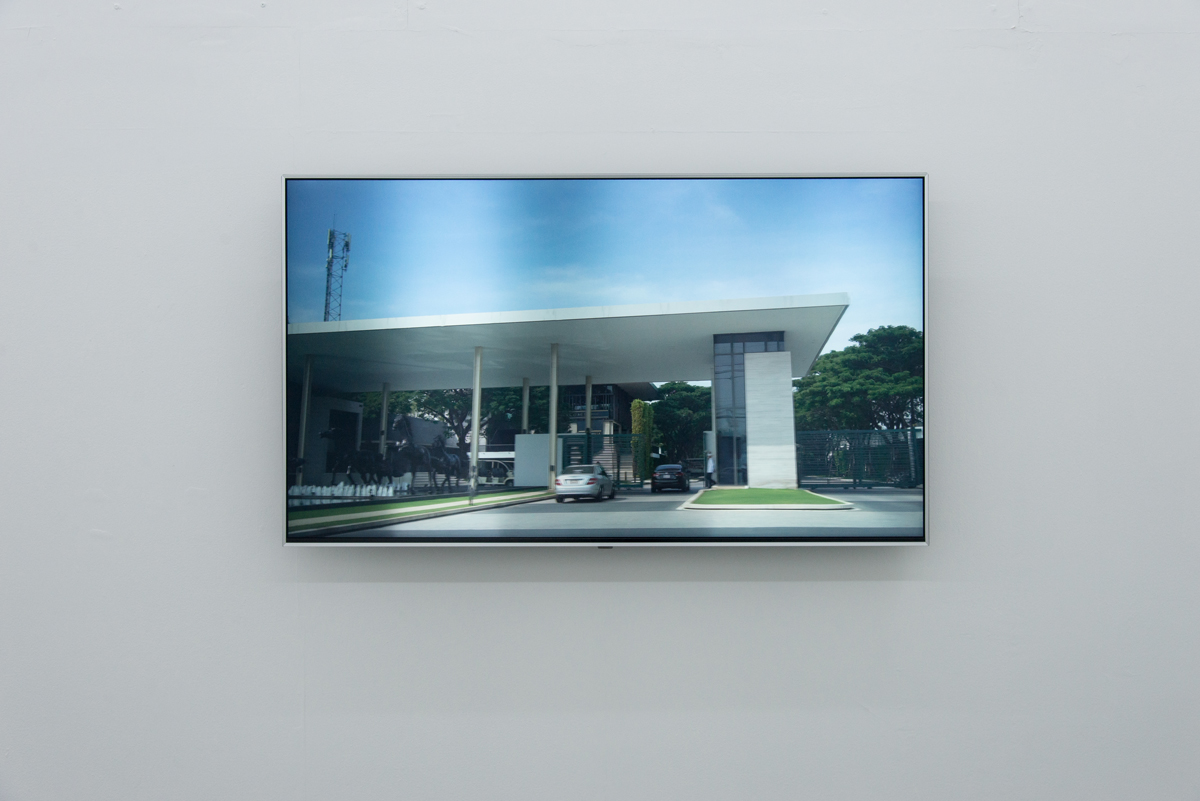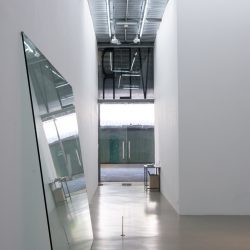AFTER THE ALMOST 5 YEARS OF THE PROCESS TO OBTAIN A LOAN, WANTANEE SIRIPATTANANUNTAKUL TURNED ALL OF THE DOCUMENTS INTO WORKS OF ART broken ladder
The turning point in Wantanee Siripattananuntakul’s artistic career took place when her father passed away in 2009 as the experience shifted her interest in art that used to be focused on the critique of institutions (including art institutions). Three years following her father’s departure, Siripattananuntakul held a solo exhibition, ‘(Dis)continuity,’ which revolved around the matter of time. The exhibition was comprised of three main chronological segments. The Past depicted the traces of her father, which were present in her previous works of video art. The artist used flashing beams of light as a reminder of the temporariness of The Present. The Future featured an installation of an LED screen with numbers accumulating up to 280,000+ running back and forth.

“The moving numbers were the debt caused by the exhibition. With the salary that I make, it’s almost impossible to put together an art exhibition,” Siripattananuntakul told art4d regarding how the changing conditions and limitations that were a result of the family’s loss of their primary breadwinner painted a better picture of the deviated mechanisms in the society. While the society (or the state) is urging people to support the country’s economic and financial policies, it refuses to acknowledge the succeeding problems by simply saying ‘your debt is your own problem.’ The second issue she attempts to address is “why we have to let ourselves fall into debt in order to do our jobs, considering how our contribution is needed within the society while the state itself regards this profession (artist) as an occupation with schools and universities teaching art lessons.” The two questions became the starting point for projects like Evacuated Crocs (2012) created at the time of the 2011 flood. If anybody remembers, the media featured report after report of the government’s failure to manage the crisis. One of the news pieces that made headlines at the time was that of a crocodile being found in the shallow waters that flooded Bang Bua Thong Road in Nonthaburi province. Siripattananuntakul looks at the crocodile not as an animal on the loose, but in terms of an example of the power that enables someone to own a crocodile (which no regular Joe can attain). For the Prince of Inequality (2015), the artist folded bank notes into the shapes of cockroaches before placing them on boxes, which were programmed to walk and bump into each other in the miniature city she created. The work is a critique of the unjust circulation of money in the economic system. “It’s interesting because we have a very small group of people in this world who are extremely rich and the money they make each day all goes to this place, but these people keep telling the media and the public that they don’t have any money.”

“After ‘(Dis)continuity’ I had been contemplating its result with myself and realized that I didn’t have anything left except for the red LED bulbs and the rubber floor and all valued nothing, even the automatic door was gone. Ever since then, I promised myself that if I had to put myself in a situation where I was in debt because of art, I would have to gain something in return.”
Such thought originated the principle behind her artistic creations where actual money is the only method she uses for the making of her works of art (she added that sometimes she had to use the bank notes that were folded into the shapes of cockroaches (created for one of her installation pieces) to pay for daily expenses. It eventually led her to the idea of turning the process of obtaining a home loan into an art project.
“Maybe you’re not ready for this,” was the judgment sentence made by the bank after she showed them her statement. “The whole process was incredibly difficult and complicated because my salary was quite low. It just happened that there was this project called Silpakorn x Government Housing Bank, which offered a chance for the university’s personnel to obtain a 100% loan based on their salary, which still wasn’t enough because the house I was going to buy cost 2.9 million THB.” Siripattananuntakul, however, found a way to get a soft loan using her 2011 flood victim status. The total number, which was tallied up to 2,967,199 THB, was then exhibited at the exhibition. The entire process that took almost a year to complete, not including the time she spent paying off her debt, which was the money she borrowed from the cooperative to work on her art. Siripattananuntakul refers to the whole thing as a ‘ritual’ and the traces of such ritual were turned into an artistic creation for her Broken Ladder exhibition that discusses the issue of social inequality.
The works in the exhibition include ‘The Reckoning (2018),’ a copy of the actual check for the 2,967,199 THB loan displayed on a marble stand beautifully covered with glass and ‘The Pins (2018),’ boundary markers made of 18k gold (following her principle to use cash to create her art). ‘We All Live Under The Same Sky, But We Don’t All Have The Same Horizon (2018),’ features an A3 copy of a title deed magnified to be ten times larger than the actual one and etched into a large piece of glass. When touched by the light, the shadow of the deed gradually appears on the surface of the glass (the artist explained the reason behind the obscured presentation stating that she saw the original copy for about 30 seconds before it was given back to the bank to keep). ‘Castle In The Air (2018)’ (a work that has Tanachai Bandasak as its photographer), is the result of the artist’s own surveying where she drove around upscale neighborhoods in Bangkok. Captured were images from a car window looking out at fences and entrances of suburban gated communities. The photographs were shown with the sound of a telemarketer trying to sell her a ten-million-baht house.
“Have you sold that copy of the check, ‘The Reckoning’ piece?” we asked her during our conversation. Siripattananuntakul didn’t give us a direct answer but raised an interesting issue. “It doesn’t sell for its status as a paper check. That piece of paper is a make-believe object, it doesn’t have any value on its own. What makes it valuable is because it works under a certain social agreement. But once it’s displayed in a gallery’s space, the value shifts. What it costs doesn’t equal the number written on the check.” Aside from the traces of her home loaning ritual that are turned into different pieces of art, the artist discusses the make-believe values that the society has created for certain objects (checks, currencies, pins, title deeds) and uses them as agreements that help everyone to coexist while at the same time building a cage that locks ourselves in this system. The issue that questions the true value of the check is answered by four golden pins that are placed at four different corners of the room. In the real word, the value of a concrete pin equals almost zero, but in this exhibition, the pins, which serve no function as a boundary marker, are valuable, not only because of the 18k gold that they are made of, but also their artistic value.


Siripattananuntakul’s answer to our question about the commercial value of the check used for the making of ‘The Reckoning’ and whether it can be sold was “yes, but it shouldn’t be.” Technically speaking, the document that is the proof of a loan is a loan agreement while the copy of the original check is needed when the borrower wishes to apply for refinancing. From this aspect, the attempt to shift the value of the bank check by putting it in the context of an art space is not taken to the extreme. In other words, the work doesn’t really turn the check into an actual art piece because at the end, that piece of paper still has its role and contains its value in the real world. “A lot of people said that my debt is my own problem, and my answer to them was that I’m aware that it’s my own personal issue, but isn’t the debt I own a reflection of the society?”, stated Siripattananuntakul as she wrapped up our conversation with her own question. The very essence of Broken Ladder is what Thanavi Chotpradit wrote in the exhibition’s introductory article – ‘How can one make something out of him or herself under this circumstance?’; the circumstance where the rich keeps getting richer and the middle incomers console themselves with the classic phrase “cut your coat according to your cloth” and try to go on with their lives.

จุดเปลี่ยนการทำงานศิลปะของวันทนีย์ ศิริพัฒนานันทกูร เริ่มขึ้นเมื่อพ่อของเธอเสียเมื่อปี พ.ศ. 2552 หลังจากที่ทำงานศิลปะวิพากษ์สถาบันต่างๆ มาตลอด (รวมถึงสถาบันศิลปะเองด้วย) 3 ปีให้หลังจากนั้น เธอมีนิทรรศการเดี่ยว (Dis)continuity ที่ว่าด้วย “เวลา” นิทรรศการแบ่งออกเป็นสามส่วนใหญ่ๆ ส่วนอดีตเป็นร่องรอยของพ่อเธอที่ปรากฏอยู่ในวิดีโออาร์ตชิ้นก่อนๆ ส่วนปัจจุบัน เธอกระตุกคนดูด้วยการยิงแฟลชแรงๆ ใส่ตาให้คนดูสัมผัสถึงสภาวะชั่วขณะของปัจจุบันและส่วนอนาคตเป็นจอ LED มีตัวเลข 280,000 (กว่าๆ) วิ่งกลับไปกลับมา
“ตัวเลข 280,000 คือหนี้ที่เกิดจากนิทรรศการนี้ ด้วยเงินเดือนแค่นั้นการทำนิทรรศการมันแทบเป็นไปไม่ได้เลย” วันทนีย์บอกกับ art4d ว่าสภาพบังคับและข้อจำกัดทางการเงินที่เปลี่ยนไปจากการสูญเสียเสาหลักของครอบครัวทำให้เธอเริ่มเห็นความพิกลพิการของกลไกในสังคมไทย หนึ่งคือในขณะที่สังคม (หรือรัฐ) กระตุ้นให้เราทำโน่นทำนี่ แต่กลับบอกปัดปัญหาที่เกิดขึ้นตามมาง่ายๆ ว่า “หนี้ของคุณก็คือปัญหาของคุณสิ” และสอง “ทำไมเราต้องกู้เงินมาทำงาน? ทั้งๆ ที่สิ่งที่เราทำเป็นสิ่งจำเป็นที่ต้องมีอยู่ในสังคม และรัฐเองก็มีวิชาชีพ (ศิลปิน) นี้ให้ มีสถาบันให้การศึกษาวิชานี้อยู่” สองคำถามนี้กลายมาเป็นจุดเริ่มต้นโปรเจ็คต์อย่างเช่น Evacuated crocs (2012) ที่เกิดขึ้นพร้อมกับข่าวน้ำท่วมปี 54 ถ้าจำกันได้ตอนนั้น นอกจากข่าวเรื่องความล้มเหลวในการบริหารจัดการน้ำ ยังมีข่าวจระเข้หลุดมาเกยตื้นบนถนนบางบัวทอง จังหวัดนนทบุรีด้วย วันทนีย์ไม่ได้มองจระเข้เป็นแค่จระเข้ แต่มองไปยังอำนาจในการครอบครองจระเข้ที่คนปกติทั่วไปไม่มีทางมีได้แน่ๆ นอกเสียจากเศรษฐีที่ไม่ออกมารับผิดชอบต่อเหตุการณ์ หรือ The Price of Inequality (2015) ที่ศิลปินพับเงินเป็นรูปแมลงสาบ และเอาไปติดกับกล่องที่ถูกโปรแกรมไว้ให้เดินชนกันไปทั่วในเมืองจำลองขนาดย่อส่วน เพื่อพูดถึงการไหลเวียนของเงินในเศรษฐกิจที่ไม่เป็นธรรม “การไหลเวียนของเงินก็น่าสนใจ โลกเรามีคนกลุ่มหนึ่งที่อภิมหารวยเงินที่ผลิตออกมาอยู่ทุกวันไปกองอยู่ตรงนั้น แล้วก็ให้คำตอบกับนักข่าวว่า เงินหมดๆ”
“หลังจากจบงาน (Dis)continuity เรามานั่งทบทวนกับตัวเอง แล้วก็พบว่าเราไม่เหลืออะไรเลยนี่หว่า เหลือแค่ LED สีแดง นอกนั้นพวกไฟห้อง พื้นยาง ผนัง มันก็ถูกตีเป็นของเสียเปล่า ประตูอัตโนมัติก็หายไป ตั้งแต่นั้นมาเราเลยสัญญากับตัวเองว่า ถ้าจะเป็นหนี้กับงานศิลปะ เราต้องได้อะไรกลับมาบ้าง” สิ่งนี้เป็นที่มาของหลักการทำงานศิลปะของเธอที่เธอจะใช้เงินจริงทำงานศิลปะ (เธอยังเสริมว่า หลายๆ ครั้งเธอแกะแมลงสาบเงินเอามาใช้เวลาช็อต) และทำให้เธอเริ่มคิดที่จะกู้ซื้อบ้านให้เป็นงานศิลปะ
“สงสัยจะยังไม่พร้อม” เป็นประโยคเด็ดที่เจ้าหน้าที่แบงค์พูดกับเธอหลังจากเห็นตัวเลขเงินเดือน “กระบวนการกู้มันวุ่นวายมากเพราะเงินเดือนเราน้อย แต่เผอิญตอนนั้นมีโครงการ ศิลปากร x ธอส. (ธนาคารอาคารสงเคราะห์) ที่เปิดโอกาสให้บุคลากรของมหาวิทยาลัยกู้ได้ 100% ของเงินเดือน ซึ่งก็ยังไม่พอ เพราะบ้านที่เราจะเอามัน 2.9 ล้านบาท” อย่างไรก็ตาม จนแล้วจนรอดเธอก็มีช่องทางกู้เงินจนได้ ด้วยการอาศัยสิทธิพิเศษของการเป็นผู้ประสบอุทกภัยน้ำท่วมปี 54 กู้ soft loan เพิ่มจนครบจำนวน จนเป็นที่มาของสำเนาเช็คตัวจริง 2,967,199 บาท ที่ถูกนำมาจัดแสดงในนิทรรศการครั้งนี้ ขั้นตอนการกู้ที่กินระยะเวลาเป็นปีๆ ไม่นับรวมเวลาที่เธอต้องไล่ปิดหนี้สหกรณ์ที่กู้มาทำศิลปะก่อนยื่นขอเงินกู้เป็นสิ่งที่วันทนีย์เรียกว่า “พิธีกรรม” และเธอก็นำร่องรอยของพิธีกรรมที่ว่ามาเป็นงานศิลปะในนิทรรศการ Broken Ladder เพื่อพูดถึงความเหลื่อมล้ำทางสังคม
ผลงานในนิทรรศการประกอบไปด้วย The Reckoning, 2018 สำเนาเช็คตัวจริงที่ถูกเอามาวางบนแท่นหินอ่อนครอบด้วยกระจก The Pins, 2018 หมุดหลักเขตที่ดินที่ทำจากทอง 18k (ตามหลักการทำงานของศิลปินว่าจะใช้เงินจริงทำศิลปะ) We all live under the same sky, but we don’t all have the same horizon, 2018 สำเนาโฉนดที่ดินขนาด A3 ที่วันทนีย์นำมาขยายใหญ่ 10 เท่าและสกัดลงบนกระจกบานใหญ่ ที่เมื่อกระทบกับแสงแล้ว เงาของโฉนดบนผิวกระจกจะลอยขึ้นมาเหนือผิวกระจก (สาเหตุที่ต้องเลือนรางขนาดนี้เป็นเพราะวันทนีย์บอกว่าทั้งชีวิตตอนนี้เธอได้เห็นโฉนดตัวจริงกับตาเธอแค่ 30 วินาที ก่อนจะต้องมอบให้ทางธนาคารเป็นผู้เก็บไว้) และ Castle in the air, 2018 (ที่ได้ธนชัย บรรดาศักดิ์ เป็นคนถ่ายวิดีโอ) ผลงานที่วันทนีย์ขับรถออกไปสำรวจความเป็นอยู่ของคนรวยตามจุดต่างๆ ในกรุงเทพฯ เป็นภาพการมองออกไปนอกหน้าต่างรถ เห็นรั้วและประตูทางเข้าหมู่บ้านใหญ่ๆ ตามชานเมือง คลอด้วยเสียงของเทเลเซลล์ที่พยายามจะขายบ้านราคาเป็นสิบๆ ล้านให้กับเธอ
“สำเนาเช็คตัวจริงที่เอามาแสดงในงานนี้มันขายได้ไหม” เป็นคำถามที่ art4d ถามระหว่างสัมภาษณ์ วันทนีย์ไม่ได้ตอบกลับมาตรงๆ ว่าขายได้หรือขายไม่ได้ แต่จุดประเด็นที่น่าสนใจขึ้นมาว่า “มันไม่ได้ขายได้ด้วยตัวมันเองอยู่แล้ว กระดาษเช็คมันเป็นของสมมติที่ไม่มีค่าในตัว แต่ที่มันมีค่าขึ้นมาก็เพราะข้อตกลงบางอย่างของสังคม ทีนี้พอมันมาอยู่ในแกลเลอรี่คุณค่ามันก็เปลี่ยนไป ราคามันไม่ได้เท่ากับตัวเลขที่เขียนบนเช็ค” นอกจากการโชว์ร่องรอยพิธีกรรมการกู้บ้านด้วยงานศิลปะ วันทนีย์ยังพูดถึงมูลค่าสมมติที่สังคมสร้างให้กับวัตถุบางอย่าง (ทั้งเช็ค ค่าเงิน หมุด โฉนด) และนำมาใช้เป็นข้อตกลงในการอยู่ร่วมกัน พร้อมๆ กับเป็นกรงที่ขังตัวเองไว้ในระบบนี้ ประเด็นเรื่องการตั้งคำถามกับมูลค่าที่แท้จริงของเช็คยังถูกยอกย้อนด้วยงานหมุดทองที่ฝังอยู่บนพื้นแกลเลอรี่สี่หมุดสี่มุมห้อง ในโลกแห่งความจริงมูลค่าของหลักเขตที่ดินนั้นแทบจะเป็นศูนย์เพราะทำจากแท่งปูน แต่สำหรับนิทรรศการนี้ หมุดหลักเขตที่ไม่มีฟังก์ชั่นในการกำหนดเขตแดนใดๆ กลับมีมูลค่าด้วยตัวเองเพราะเนื้อทองของมัน และคุณค่าในเชิงของงานศิลปะ
วันทนีย์กลับมาตอบคำถามว่า “เช็คขายได้หรือไม่?” หลังจากนั้น และคำตอบคือ “ขายได้แต่ไม่ควรขาย” หลักๆ แล้วเอกสารที่ใช้เป็นหลักฐานการกู้ยืมคือหนังสือสัญญากู้เงิน ส่วนสำเนาเช็คตัวจริงนั้นจะต้องใช้ก็ต่อเมื่อผู้กู้ต้องทำรีไฟแนนซ์ ตรงนี้เองที่ทำให้การเปลี่ยนมูลค่ากระดาษเช็คด้วยการนำมาแสดงในแกลเลอรี่ยังไปไม่สุด หรือพูดอีกอย่างก็คือ มันไม่ได้เปลี่ยนเช็คให้กลายเป็นงานศิลปะไปจริงๆ เพราะท้ายที่สุดแล้วเช็คก็ยังมีหน้าที่ในโลกแห่งความเป็นจริงอยู่ “มีหลายคนเลยที่ถามเราว่า หนี้ของคุณก็เรื่องของคุณสิ เราบอกไปว่า ก็ใช่ที่มันเป็นหนี้ของเรา แต่หนี้ของเรามันก็เป็นภาพสะท้อนสังคมไม่ใช่หรอ?” วันทนีย์ทิ้งท้าย ใจความสำคัญของ Broken Ladder จึงเป็นอย่างที่ ธนาวิ โชติประดิษฐ เขียนไว้ในบทความประกอบนิทรรศการ นั่นคือคำถามว่า “เราจะลืมตาอ้าปากได้อย่างไรในภาวะเช่นนี้” ในภาวะที่คนรวยก็รวยต่อไป ส่วนคนชั้นกลางอย่างเราๆก็ได้แต่ปลอบใจตัวเองด้วยวลีง่ายๆ ว่า นกน้อยทำรังแต่พอตัว
Broken Ladder หรือในชื่อไทยว่า ‘บันไดหัก’ จัดแสดงที่ Gallery VER จนถึง 31 มีนาคม 2561
TEXT & PHOTO : NAPAT CHARITBUTRA
vergallery.com



